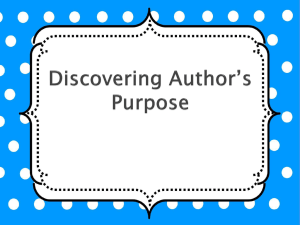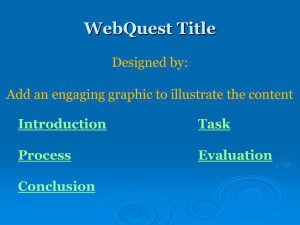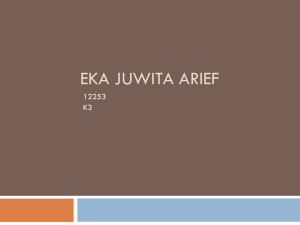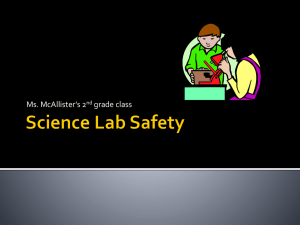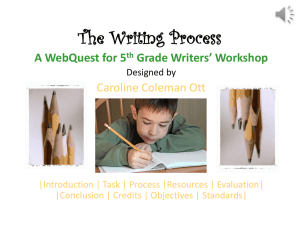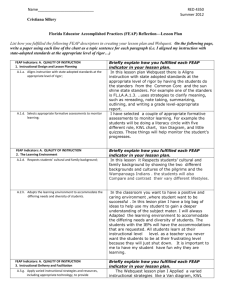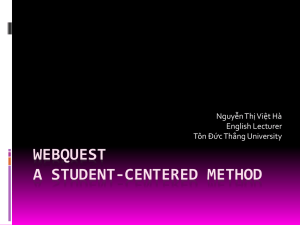3.專業教師主題探索課程設計
advertisement
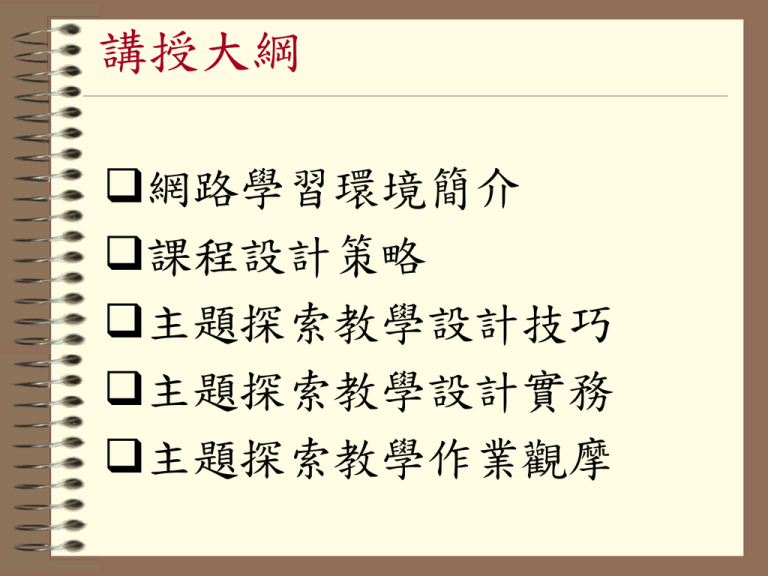
講授大綱 網路學習環境簡介 課程設計策略 主題探索教學設計技巧 主題探索教學設計實務 主題探索教學作業觀摩 專業教師主題探索課程設計:4.5小時 • • • • • • 1.網路教學環境簡介 (1 hour) .未來學校之型態 .國外peercoaching站台內涵 .教學網站資源 .教學網路環境應用範例 .個人化教學環境管理 • • • • • • 2. 課程設計策略 (1 hour) .教學網頁設計工具 .教學網頁設計的程序 .教學網頁設計的準備 .多媒體物件介紹 .多媒體物件的編輯工具 • • • • • 3.主題探索教學設計技巧 (1 hour) . Lesson design 的要件 . Senario design的要素 . 範例介紹 . 設計技巧 • • • 4. 主題探索教學設計實務 (1 hour) .作業規劃 .線上實務 • 5. 主題探索教學作業觀摩 (0.5) 3.專業教師主題探索 課程設計 樹德科大教務長 溫教授嘉榮 主題探索 定義 學習活動應以主題為導向 主題的規劃與學習環境的設計 應切合學習者的生活情境 學習者經由實際參與解決生活 中的問題,而使學習者能對學 習主題有深刻的認識與了解 加深加廣的學習活動 主題探索 特色 以學習者為學習歷程的主體 解決問題取向 重視人際及社群合作學習 單一主題、 多元探索 重視建構知識(meta knowledge) 的過程 主題探索 策略 由做中學 過程比結果重要 創意是快樂的泉源 情境化學習 學習環境(步道)的建置 分享成果的喜悅 科技在主題探索的角色 以電腦及網路為輔助工具 資訊融入 線上(Online)合作學習 資料搜尋與統整 學習過程記錄 主題探索式網路課程(WebTheme Title) 課程設計思考要素 以學習者經驗為基準 配合課程及學習目標 三層次的同心圓 學習者 同儕 群體 主題課程設計四個面向 經驗連結 問題解決 學習者 知識取得 觀察探索 統整課程設計 Forgaty在“Ten Ways to Integrated Curriculum“文中,提出十種課程統整方式 分立式 fragmented 共有式 shared 窠巢式 nested 聯立式 connected 張網式 webbed 統整課程設計(Forgaty ) 並列式 Sequenced 沈浸式 immersed 串聯式 threaded 整合式 Integrated 網路式 networked 設計技巧 概念圖 運用inspiration視覺化工具 Big Six 系統資訊問題解決過程六步驟 WebQuest 設計與流程的六個構成要素 FOCUS Five Rules for writing a Great WebQuest 概念圖(inspiration) The Big Six 界定問題 擬定資訊尋找策略 利用資訊 找出並選擇資訊 組織資訊 評估 WebQuest 1995 年聖地牙哥州立大學Bernie Dodge & Tom March教授提出 整合學習策略與應用網路資源,規 劃探究導向的教學活動 教師應整理好相關資源網站,引導 學生針對主題進行探索 以任務為取向,進行高階思考 What is WebQuest? • An inquiry-oriented activity in which some or all of the information that learners interact with comes from resources on the internet. • Present student groups with a problem( usually in the form of scenario) with a set of challenging tasks to solve. • Usually students divide into groups. In the groups each students or pair of students have a particular role, task, or perspective to master. They effectively become experts on one aspect of a topic. When the roles come together, students must synthesize their learning by competing a summarizing act such as e-mailing congressional representatives or presenting their interpretation to real world experts on the topic. 目標 • Knowledge acquisition and integration, or extending and refining knowledge (depending on what type of WebQuest activity—Short term or longer term WebQuest) • Students can explore the breadth of perspectives and viewpoints of the complex issue discussed. • Students can make sense of the multi-faceted aspects involved in the task. • Students can be exposed to the rule of reasoning and the spirit of support of claims (scientific reasoning) WebQuest實施流程構成要素 Introduction:動機與情境引導 Task:學習任務的描述 Process:探索過程的安排與指引 Resources:網站連結或資源列表 Evaluation:說明評分方式 Conclusion:總結本次學習意義,並提 出新問題或補充,提供延伸加廣學習的 機會 Teacher Page: 提供教師參考之用 活動設計要素-1.Introduction(1/4) • To both prepare and hook the reader. • A short paragraph to introduce the activity/problem to the students. • An introduction provides some background information related to the involving context/issue that sets the stage. • If there is a role or scenario involved(e.g., “you are a detective trying to identify the mysterious poet.”) Here is where you’ll present the Big Question (Essential Question, Guiding Question) that the whole WebQuest is centered around. 活動設計要素-1.Introduction(2/4) 情境學習意義 • Schon提出了「在行動中求知」(knowing in action)及「在行動 中反省」(reflection in action)的學習概念,即是情境學習理論 的重要內涵之一。 • Suchmon(1987)觀察人們操作影印機時發現,大部分的人並 非先閱讀完使用者手冊後再操作機器,而是在使用過程中遇到 困難時,再查閱說明書或直接請教有經驗的人。所以Suchman提 出了「情境行動」(situated action)的觀點,強調知識若脫離使 用情境,則學習就變成玩抽象符號的遊戲。況且,知識中的許 多概念及規則必須透過實際的經驗來揣模,由實際行動中才能 理解其真正的含意。 活動設計要素-1.Introduction(3/4) 情境學習對現代教學的啟示 • 知識植基於情境脈絡當中,透過參與生 活情境中的活動,學習者才能真正掌握 知識。 • 知識如同生活中的工具,必須透過使用 才能瞭解它們。 • 學習是一個涵化(enculturation)的歷程, 教學應提供完備的範例,與在真實情境 中使用該專業知識的機會,以滿足學生 深入瞭解文化的需求。 活動設計要素-1.Introduction(4/4) 情境學習對現代教學的啟示 • 知識具有社會共享(socially shared)與 分配(distributed)的特性,提供異質性 團體有助於形成「近側發展區」。 • 學習應從周邊參與(peripheral participation)開始,教師應善用故事、 遊戲或實做等方式,讓學生進入文化脈 中,透過對話以及參與活動產生有意義 的學習。 • 教學是一個知識溝通的過程,善用教育 科技可豐富知識表徵,擴展學習深度。 活動設計要素—2.Task • The task focuses learners on what they are going to do—specifically, the culminating performance or product that drives all of the learning activities. • Describe crisply and clearly what the end result of the learners’ activities will be. 活動設計要素—3. Process • Process outlines how the learners should to through in accomplishing the task( clearly described steps). • Might include step-by-step procedure, resources and tools for organizing information. 活動設計要素—4. Resources • A set of information sources needed to complete the task. • Pointers to resources are included so that the learner is not left to wander through webspace completely adrift. • Include a brief description for each resources for guidance (Hotlist). 活動設計要素—5. Evaluation • Describe how learners’ performance will be evaluated in terms of both process and outcomes. • Evaluation criteria(i.e., assessment rubric) should align with the culminating project or performance, as outlined in the task section of the WebQuest as well as important behaviors during the process. • Specify whether there will be a common grade for group word v.s individual grades. • May develop rubrics to further assist evaluation. 活動設計要素— 6. Conclusion • Brings closure to the quest, reminds the learners about what they’ve learned. • Encourages them to extend the experience or their thinking beyond this lesson into other contents/domain by including additional task/questions/links to encourage them to extend. 活動設計要素— 7. Teacher Page 1) 2) 3) 4) 5) 6) 7) 8) 9) Introduction Content Area and Grade Level Curriculum Standards Implementation Overview Resources Needed Entry Level Skills and Knowledge Evaluation Possible Variations Conclusion Teacher Page—1 introduction • Introduction specify (a) the learning goal (b) task of the learning activity. Teacher Page 2. Content Area and Grade Level Content Area and Grade Level specify (a) the target audience (b) subject matter/content area focused Teacher Page 3.Curriculum Standards • Curriculum Standards specify both (a) subject matter objectives (b) technology objectives Teacher Page 4. implementation overview Implementation overview describes (a) the learning context (b) day-to-day implementation plan aligned with process Teacher Page—5. Resources • Resources specify the needed hardware, software, facility, staffs, references (both web and non-web), etc. for successful implementation. Teacher Page 6. Entry Level Skills and Knowledge Evaluation delineate (a) Criteria (b) Process related to evaluation while conducting a WebQuest in class. And the end of the WebQuest, students will complete an evaluation for themselves, and one for their partner. Teacher Page 7. Possible Variations • Possible variation show how the activity can be extended and enhanced by including follow-up activities in the same of other content areas for other teachers’ references. Teacher Page—8. Conclusion • Conclusion sum up the learning activity (tie up with introduction) 注意事項(1/2) • Information sources might include web documents, experts available via e-mail or realtime conferending, searchable databases on the net, and books and other documents physically available in the learner’s setting. • WebQuests might be enhanced by giving the learners a role to play (e.g. scientist, detective, reporter, historian, photographer, etc.), simulated personae to interact with via email/videoconferencing, and a scenario to work within (e.g., you’ve been asked by the Secretary General of the UN to brief him on what’s happening in sub-Saharan Africa this week.) 注意事項(2/2) • WebQuest can be designed within a single discipline or they can be interdisciplinary. • It’s best to choose a topic that is under dispute or that at least offers a couple different perspectives. • Current events, controversial social and environmental topics work well. WebQuest Example • 救救漁夫: http://course.fed.cuhk.edu.hk/s031705/ED D5169F/ • http://www.berksiu.k12.pa.us/webquest/bo wman/index.htm • http://et.sdsu.edu/APaxtonsmith/eslwebquest/WebQuest.htm • http://www.geocities.com/SiliconValley/M ouse/8059/CurriculumQuest.html http://webquest.sdsu.edu/materials.htm http://projects.edtech.sandi.net/staffdev/buildin gblocks/p-index.htm FOCUS :Five rules Find great site:發現很棒的網站 Orchestrate your learners and resource:學習資源的連結 Challenge your learners to think:提 供合適的挑戰以鼓勵學習者思考 Use the media:善用媒體 Scaffold high expectations:提供鷹 架以建立學習遷移並產出創新作品 範例一 http://projects.edtech.sandi.net/grant/ oceanpollution/introduction.html 範例二 http://inshow.idv.tw/webs/oldstreet/d efault.htm 情境教學 定義 情境學習強調知識是學習者與 情境互動的產物(擬真環境) 本質上深受活動、社會脈絡及 文化的影響 依知識建構的經驗而產生問題 解決(problem-solving)之技能 情境教學範例 英文 http://www.liveabc.com/site/situation/immigration/i mmigration3.html 情境教學範例思考 數學—商店 自然—沙漠求生 生物—SARS 經濟—線上旅遊經營設計 決策—麻省理工之啤酒遊戲 ………

